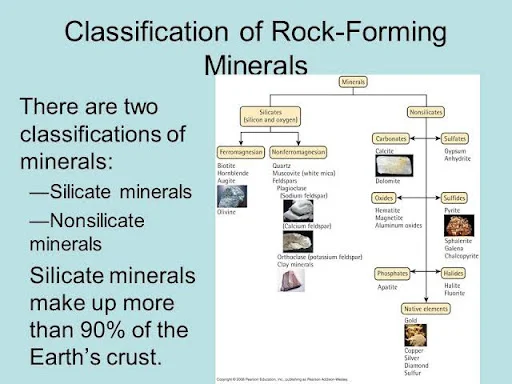Minerals : Classification and Physical properties
Mineral is a naturally occurring, homogeneous inorganic compound having fixed chemical composition and atomic structure formed due to inorganic processes of the Earth.
Classification of Rock forming Minerals
These are mainly of two types
I Silicates
Silicates again subdivided into
1. Ferromagnesian minerals
i) Olivine group of minerals
ii) Pyroxene group of minerals
iii) Amphibole group of minerals
iv) Biotite
2. Non Ferromagnesian minerals
i) Feldspar group of minerals
ii) Quartz group of minerals
iii) Muscovite
II Non Silicates
Oxides
Sulphides
Sulphates
Carbonates
Physical Properties of Minerals
Minerals are identified on the basis of following physical properties
1. Colour
2. Streak
3. Lustre
4. Fracture
5. Cleavage
6. Hardness
7. Specific Gravity
8. Form and structure
1. Colour
The colour of a mineral depends on the absorption of some and reflectance of other of the coloured rays which constitute the white light.
2. Streak
Streak of a mineral is the colour of its own powder which is produced due mark on the porcelainite plate. The streak of a mineral is not always similar to its colour.
For example
i) Hematite has colour brownish black but streak is Cherry Red.
ii) Chalcopyrite has colour golden yellow but its streak is greenish black.
3. Lustre
It is the amount of shining of a mineral that is produced due to reflection of light.
There are mainly two types of lustre
A) Metallic Lustre
All the metals have metallic lustre.
E.g. Hematite, Magnetite, Cuprite, chalcopyrite, galena etc.
B) Non Metallic Lustre
Other than metallic minerals all minerals have non metallic lustre.
There are following types of non metallic lustre
a) Vitreous Lustre
It is the shining of a glass or quartz. Most of the minerals ( about 90%) have vitreous lustre.
b) Resinous Lustre
It is the shining of resin.
c) Pearly Lustre
Shining of pearl. E.g. Talc.
d) Adamantine Lustre
Shining of Diamond.
4. Fracture
It is the nature of the broken surface of the mineral. These may be
a) Even Fracture
The broken surface of a mineral is smooth and plane.
b) Uneven Fracture
The broken surface of a mineral is rough.
c) Conchoidal Fracture
The broken surface of a mineral is curved. Most of the minerals have Conchoidal fracture.
d) Hackly Fracture
The broken surface of a mineral is needle shaped.
5. Cleavage
Cleavage of a mineral is the tendency to breakdown to a particular direction. Cleavage is absent in quartz group of minerals.
6. Hardness
It is the resistance power of a mineral.
Moh's scale of hardness is as below
Talc is the softest mineral and diamond is the hardest mineral.
7. Specific Gravity
It is the ratio of the weight for the mineral in air to the weight of equal volume of water displaced.
Thus,
Specific Gravity = W1/ W1-W2.
Here
W1 = weight of mineral in air.
W2 = weight of mineral in water.
8. Form
All minerals are either in crystalline or in non crystalline form.










Comments
Post a Comment